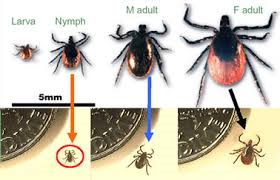
Steps to protect yourself from tickborne disease
To stay disease free, it’s important for all to clearly understand tick encounter risks and preventive solutions
Tick infestation issues have changed significantly since the 1980’s when blacklegged ticks (a.k.a. deer ticks) first really came onto the scene, and Lone Star tick populations exploded in places they never were found before. American dog ticks and wood ticks, once the most common ticks, have taken a backseat to these two other human biters in much of the USA. Spring is here and ticks are in our woods, back yards, grassy areas and trails in full force searching for a blood meal from an animal or human host. Residents in towns in Western Middlesex County, where ticks are particularly prevalent, might know or know of a family member, friend or neighbor who has been treated for one of the three tickborne diseases that are becoming widespread in our area: Lyme, Anaplasmosis (Erlichiosis), and Babesiosis. These diseases can seriously impact an individual’s health and life-style, and it’s important to learn about the diseases, their symptoms and ways in which you can protect yourself and loved ones in the coming months. Anyone who spends time outdoors should be aware of tickborne disease and should check themselves regularly for ticks. These are the top ten facts that everyone needs to know in order to stay safe:
Top 5 Tips
- Get the facts. Learn to identify ticks and the diseases they may carry (see “10 Essential Facts” below).
- Focus on preventing the spread of disease through ticks using daily tick checks and consider the use of tick repellent clothing. Post tick check reminders/charts in shower and sleeping areas.
- When ticks are found, assess whether or not they might pose a risk (see “4 Essential Skills below).
- Include the right tick-removal tools (pointy tweezers).
- Understand how to avoid tick habitats. Ensure that tick removal is done properly.
Disease Transmission by Ticks
Ticks also carry a wide variety of disease-causing germs and they transmit these agents while bloodfeeding. They are obligate blood feeders (blood is all they feed on), and they typically stay attached to their host for days or a week to complete feeding (in contrast, mosquitoes are quick-in/quick-out blood feeders).

10 Essential Tick Facts
- All ticks crawl up (think protection from the ground up), but you also need to check your hair and scalp for ticks.
- All ticks (including deer ticks) come in small (larvae), medium (nymphs) and large (adult female/male) sizes.
- Ticks can be active even in the winter.
- Ticks carry a variety of disease-causing microbes.
- Deer ticks transmit Lyme disease bacteria.
- For most tick-borne diseases, you typically have at least 24 hours to find and remove a feeding tick before it transmits an infection. However, you should contact your doctor if you have found a tick on your body that is attached.
- Some ticks can be hard to see or feel–deer tick nymphs look like a poppy seed on your skin.
- The easiest and safest way to remove a tick is with a pointy tweezer.
- Tick repellent clothing with permethrin is best for preventing tick bites.
- Tick bites and tick-borne diseases are preventable.
Four Essential Steps
#1: Identify Ticks Correctly
While not completely foolproof, the method of recognizing the striking coloration and size of the adult stages make them fairly easy to identify, while the immature stages are often so small that it can be difficult even to see the tick, much less the distinguishing characteristics. At the very least you will need at least a 3X magnifier to see specific characteristics on adult ticks, and you may need the same magnification just to see the immature stages. If possible, magnify the tick 10-30 times normal size in order to get a good look.
#2: Remove Ticks Safely
To safely remove attached ticks, first disinfect the area with an alcohol swab. Next, using pointy tweezers or tick removal tool, grab the tick “head” as close to the skin as possible and simply pull straight out. Remember to disinfect the bite site again after pulling the tick out.
Consult your physician if you have recently removed an imbedded deer tick.
#3: Consider Tick Risks
There are commercial laboratories that will test ticks to detect the presence of various pathogens, especially Lyme disease-causing bacteria.
LYME DISEASE
Lyme disease, also known as Lyme borreliosis, is an infectious disease caused by bacteria of the Borrelia type. The most common sign of infection is an expanding area of redness, known as erythema migrans, that begins at the site of a tick bite about a week after it has occurred. The rash is typically neither itchy nor painful. Approximately 25–50% of infected people do not develop a rash. Other early symptoms may include fever, headache and feeling tired. If untreated, symptoms may include loss of the ability to move one or both sides of the face, joint pains, severe headaches with neck stiffness, or heart palpitations, among others. Months to years later, repeated episodes of joint pain and swelling may occur. Occasionally, people develop shooting pains or tingling in their arms and legs. Despite appropriate treatment, about 10 to 20% of people develop joint pains, memory problems, and feel tired for at least six months.
UMass Extension Tick Diagnostic Lab
Attn: Tick Assessment
Holdsworth Natural Resources Center, 160 Holdsworth Way
University of Massachusetts, Amherst, MA 01003-9285
Use exact address to ensure delivery.
For specific information, contact: Dr. Craig Hollingsworth, (413) 545-1055
While not all ticks carry disease-causing microbes, some can be heavily infected. It’s usually a good idea to save the tick and make a note as to when it was removed.
- On average, about 1 in 5 nymphal-stage deer ticks and 1 in 2 adult-stage deer ticks carry Lyme disease bacteria.
- Tick infection rates can vary by location.
#4: Conduct a Daily Tick Check
Prompt removal of most species of ticks can prevent transmission of tick-borne pathogens. It typically takes more than 24-36 hrs of attachment for nymphal deer ticks to transmit Lyme disease bacteria, and even longer to transmit Babesia parasites. Pathogen transmission delays after tick attachment are a fairly common phenomenon with the exception of tick-transmitted viruses.
- The best time to do a full body tick check is right after ending outdoor activity.
- A more convenient and still ok time would be as you prepare to shower or bathe before going to bed.
- Good lighting, a tick check buddy (for those hard-to-see places), or strategic use of a mirror are helpful resources
- Reminders to do a daily tick check should be posted in both shower and sleeping areas.
Tick Repellent Clothing
DEET-containing products were thought to be a good option for preventing tick bites. However, recent tests have shown that although DEET is an excellent repellent for mosquitoes, black flies and gnats, it’s only effective at repelling ticks for brief time periods after being applied and then must be re-applied. A better option for repelling ticks are “Clothing Only Repellents” such as those containing Permethrin (found in Permanone® Products, Sawyer Clothing-Only Repellent® and Repel®). These products contain about 0.5% Permethin, much less than the amount used to treat head lice on children or Scabies mite infestations of the skin. In the case of tick repellents, using more of the active ingredient than this is unnecessary, and can even lead to chemical overexposure.
You can purchase tick repellent clothes containing permethrin (easiest and most cost-effective) or use sprays and soaking kits to treat your own clothes with permethrin tick repellent. Commercially treated clothing remains tick repellent through 70 wash cycles while treat-at-home sprays and kits provide effective repellency for up to 6 washings. Brands include Insect Sheild, ExOfficio; Bugs Away. Whichever method you choose, wearing tick repellent clothing makes tick bite protection and disease prevention as easy as getting dressed in the morning!
Resources
- Stop Ticks!- Centers for Disease Control and Prevention:www.cdc.gov/Lyme
- Tickencounter (The University of Rhode Island, Thomas Mather, Ph.D.): www.tickencounter.org
- Lyme Disease Facts – Centers for Disease Control and Prevention
- Mass Department of Public Health: www.mass.gov/dph/tick
Strategies and Preventative Solutions for Reducing Tick Encounter
To stay disease free, it’s important for families to clearly understand their tick encounter risks and preventive solutions
Tick Habitats
Different species and stages of ticks have quite different host associations and environmental requirements. This means that they are likely to be distributed in different places across the landscape and encounter rates can differ greatly. Most ticks fear drying out the most-some are more sensitive than others. Immature stages (larvae and nymphs) are typically more common in leaf litter, while adult stages may crawl higher on vegetation to latch on to their hosts. Shady edges are favorite spots for ticks to hang out. Avoiding tick habitat can be difficult but there are plenty of ways – such as always walking in the middle of maintained trails – to limit tick encounters.
Resources: Centers for Disease Control and Prevention, The University of Rhode Island, Thomas Mather, Ph.D.,










